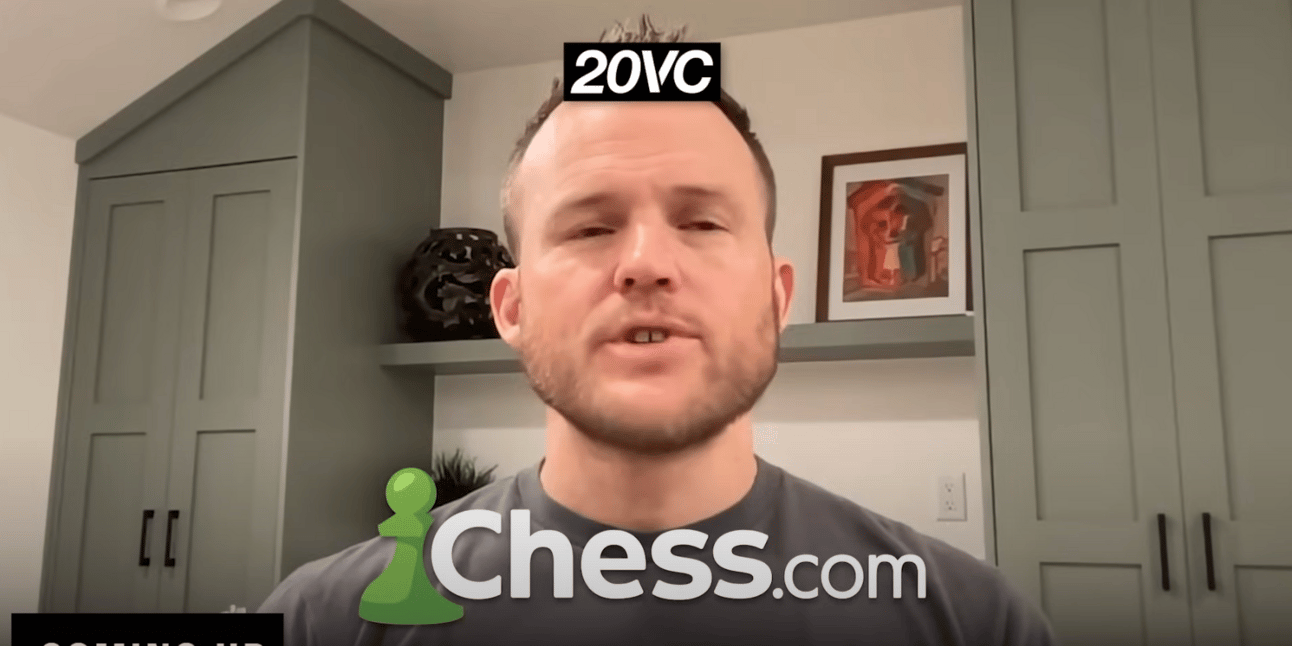- Tech Podcasts This Week
- Posts
- Tech Podcasts This Week
Tech Podcasts This Week
Bootstrapping to $100m

Hey friends,
Welcome to Tech Podcasts This Week, where we did the work of listening to 23 hours of tech podcasts and picking out the best bits - ready for you as a 3 minutes read.
Don’t waste time listening too all that audio. Get the best of it here on tech trends, productivity, startups, investing and artificial intelligence.
If you are not already subscribed to the newsletter, please subscribe here. And if you forward this to a friend, we will love you forever.
GS
\The Best… Startup Story
How he bootstrapped to $100m in revenue

This week’s 20VC shared the story of Chess.com founder Erik Allebest, who scaled the platform $100M Revenue with no VC funding. Here is the Chess.com story & his top tips for bootstrapping a business.
The story:
2005: Chess.com is founded by Eric and his business partner. The domain is acquired from a bankruptcy auction for $56,000.
Early Years (2005-2007): No online chess, just a site with chess content like news and forums.
2007 to 2015: The platform introduces online chess play, allowing users to play directly in their web browsers.
2015-2019: The site experiences significant growth driven by strategic content creation and a better platform.
2020 (COVID-19): Explosive growth as people are bored at home playing chess online. Then in October 2020 "The Queen's Gambit" is released on Netflix, which helps as well.
2021-2023: Chess.com solidifies its position as the leading online chess platform, reaching over 100 million registered users and generating over $100 million in annual revenue.
Lessons on Bootstrapping:
Focus on Sustainable Growth and Immediate Monetization. "We thought about monetizing immediately,” he said, explaining how every bit of content or idea had to make money from day one.
Embrace Remote Work to Keep Costs Low. "Everybody was remote, there was no office."
Prioritize Community and Customer Value Over Everything. "The weight of our mission crushes egos... It crushes politics, it crushes [expletive], it crushes egos.”
Adapt to Market Needs: Flexibility is key when you're bootstrapping. Be ready to pivot your business model, product, or service based on feedback from your customers and changes in the market.
Growth Takes Time: Bootstrapped businesses often grow more slowly than those with substantial external funding.
Celebrate Small Wins: Each milestone, no matter how small, is a step toward your larger goal. Celebrate these wins to maintain motivation and team morale, especially when the pace of growth feels slow.
Reinvest Profits: Use the profits you generate to reinvest in the business. This approach allows for organic growth and can help you scale without the need for external financing.
\The Best… on AI
Good (and bad) ideas for AI startups today

This week the Y Combinator Group Partners say what makes a good AI idea - and a bad one.
What makes a good idea?
Solving Mundane Problems: Startups focusing on automating mundane tasks like workflow automation, information summarization, and form filling using LLMs are finding success. This approach targets replacing repetitive human tasks with AI, addressing real and widespread needs.
Developer Tools and Prompt Engineering: Tools that assist in prompt engineering, testing prompts, and observing second-order effects are gaining traction. This taps into the need for more efficient and effective use of AI models by developers.
Niche and Vertical Solutions: Companies that dive deep into specific industries or problems, offering tailored AI solutions, are more likely to succeed. Examples include automating the search and application process for government contracts, indicating a trend towards solving highly specific pain points with AI.
Mistakes to avoid
Avoiding Generic Solutions: Founders should focus on specific needs and avoid building too general or abstract solutions that do not address concrete problems. Tailored solutions to unique business logic or compliance requirements have a better chance of success.
Beware of AI Tar Pits: These are ideas that seem attractive but end up trapping entrepreneurs without leading to a viable business. Founders should be wary of jumping into highly competitive or unclear markets without a clear differentiator.
Overreliance on Large Models: Depending solely on the capabilities of large models like GPT-3 or GPT-4 without adding significant value or customization can be risky. Companies need to add unique business logic, user experience, or proprietary data to stand out.
\The Best of… All In Pod
The Vision Pro is Awesome

Here are the three key insights from this week’s All In podcast with Chamath Palihapitiya, Jason Calacanis, David Sacks & David Friedberg
Virtual Reality and Apple Vision Pro: David Freeberg shares his experience with Apple Vision Pro, describing it as a game-changing augmented reality device. "The AR is game-changing...it gets rid of all that dizziness...that happens with the full VR experience."
Impact of Technology on Productivity: Freeberg discusses the potential of AR technology to significantly improve productivity in various sectors, like agriculture, through streamlined data and image collection processes. "...productivity will go up by 10x with these goggles."
Societal Impact of Immersive Technologies: Chamath Palihapitiya raises concerns about the societal implications of increasingly immersive technologies, suggesting they might exacerbate issues like depression, loneliness, and social detachment. "...may not be the solution to our problems."
Comparison of Human Skills and AI: The conversation touches on whether advancements in AI and robotics (like Elon Musk's Optimus) will lead to humans enhancing their capabilities or robots becoming more human-like
Apple Vision Pro's Market Potential: Despite its high price, Freeberg predicts significant sales for Apple Vision Pro, suggesting it could transform enterprise applications. "...I think they're going to own the entire space."
Impact of Technology on Youth: The podcast touches on the adverse effects of technology on young people, with discussions on increasing rates of depression and the need for real human connections. "The lack of marriage, the lack of kids...are in some way a correlated byproduct of this entire immersive...world."
The Business Case for VR and AR: Sacks reflects on the evolution of VR and AR, suggesting that while the technology is promising, its full potential and primary use cases are still being explored. "I don't think we're quite there yet."
Role of AI in Enhancing Existing Technologies: The conversation veers into how AI, like the Apple Vision Pro, can enhance traditional work processes and entertainment, suggesting a mixed outlook on its integration into daily life.
\The Best on Health
The Loneliness Neuron

Kay Tye, a professor of systems neurobiology at the Salk Institute for Biological Studies joins Andrew Huberman for a discussion around the neural circuit basis of social interactions and loneliness. Here are the key takeaways:
The Amygdala's Role in Positive Reinforcement: The amygdala, traditionally associated with fear and threat detection, but it actually plays a crucial role in reinforcing behaviors and experiences that are positive and involve reward.
Discovery of Loneliness Neurons: There has been a discovery of neurons that specifically contribute to the sensation of loneliness, suggesting a direct neural basis for feelings of social isolation. There are “neurons that give us that sense that we are not being fulfilled from our social interactions."
Social Homeostasis: The concept of social homeostasis, which is the idea that there is a balanced state of social interactions humans strive for, whether they are introverted or extroverted. There is a “phenomenon she discovered called social homeostasis, which is our sense that we are experiencing enough, not enough, or just enough social interaction..."
Impact of Social Media on Social Fulfillment: Social media and online interactions, despite their breadth, often fail to fulfil our social needs because they don’t trigger the neurons in the same way. “Despite extensive interaction with many, many individuals, those social media and online interactions can often leave us feeling deprived in specific ways."
\The Best of… Time Management
Focus on your “daily highlight”

Five bits of advice on product management from Megan Cook, head of product for Jira.
The Importance of Identifying a Daily Highlight: The concept of a daily highlight is pivotal for focusing energy and attention on what truly matters. "The notion with the Highlight is imagine it's the end of the day if someone asked you what was the highlight of your day what would you say? That's the anchor of everything."
Limited Willpower in Facing Distractions: Willpower alone is insufficient to resist distractions, emphasizing the need for creating barriers. "The basic principle with laser is that your willpower is never gonna win... it's all about making it hard, creating barriers to getting distracted."
The Integration of Physical and Mental Well-being into Productivity: Energizing oneself through good sleep, nutrition, and exercise directly impacts one’s ability to focus and be productive. "Energize is about having the right amount of energy to do the thing, to pay attention... these are just tactics around sleep and food and exercise."
The Power of Reflection for Continuous Improvement: Reflecting on the day’s activities and outcomes enables a mindset of curiosity rather than self-judgment, fostering continuous improvement. "Reflect is just simply the act of looking back on the day and treating the day like it wasn’t a... marble gravestone of your successes or failures, it’s just an experiment that you ran."
The Effectiveness of Design Sprints in Product Development: In product manaegment, design sprints are a structured, time-constrained process that helps teams go from idea to prototype to testing within a week, enabling fast learning and decision-making. "The big idea with a design Sprint is to go from zero to a prototype and a test of that prototype in just five days... it's a tool for doing that and it uses a lot of these principles we talked about with Make Time."